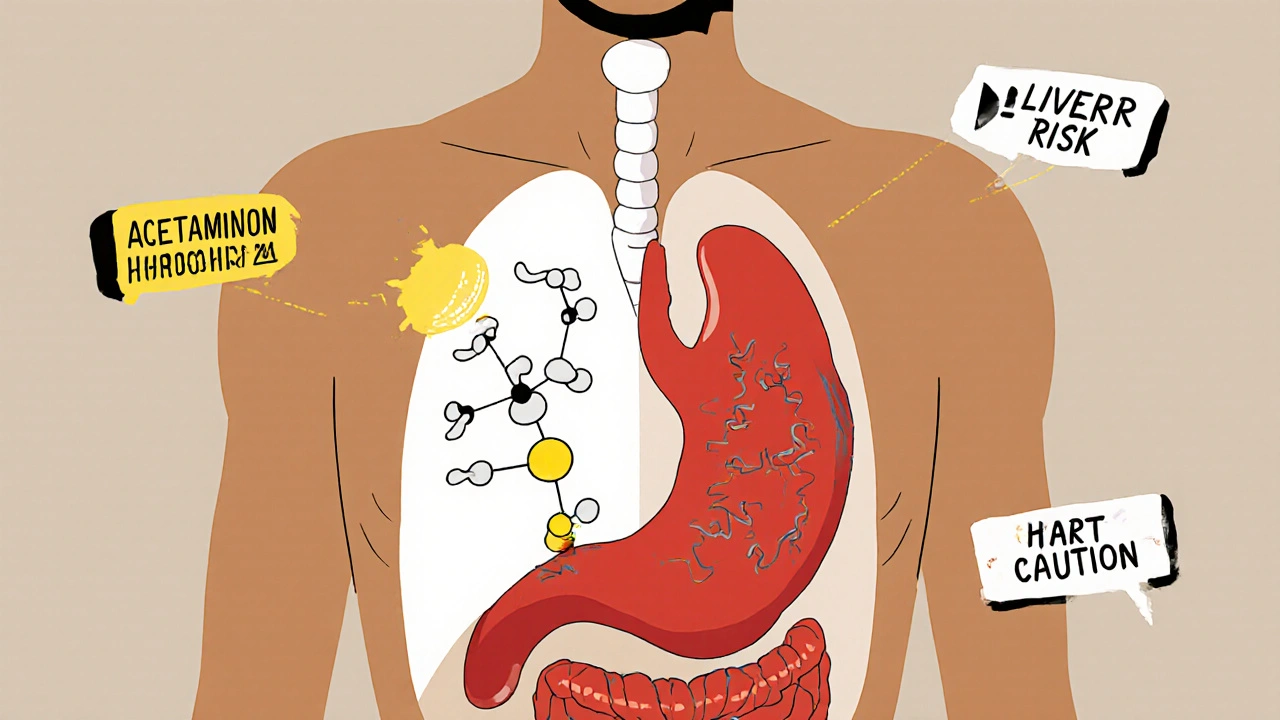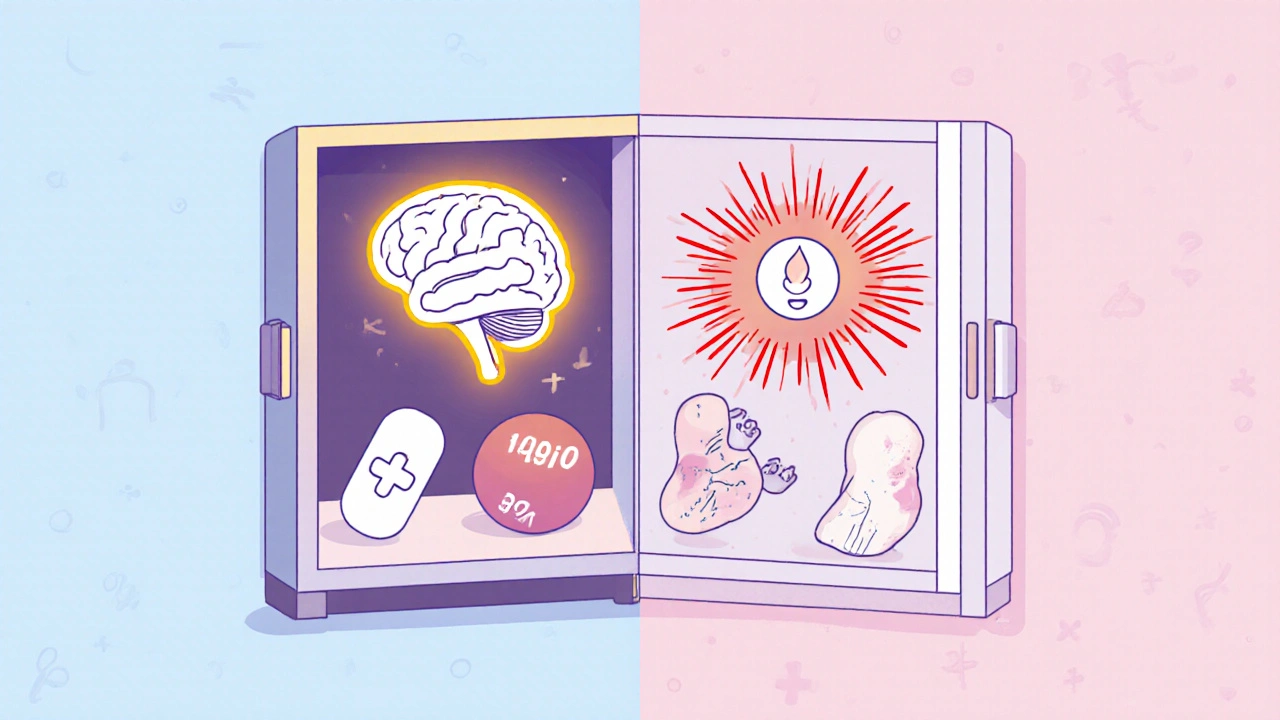When you have a headache, sore muscles, or a fever, reaching for an OTC pain reliever seems simple. But not all pain pills are the same. Two main types dominate the shelf: acetaminophen and NSAIDs. Choosing the wrong one could mean less relief-or worse, harm. Knowing the difference isn’t just helpful; it’s essential.
What’s the Real Difference Between Acetaminophen and NSAIDs?
Acetaminophen (sold as Tylenol, Panadol, and many generics) and NSAIDs (like ibuprofen, naproxen, and aspirin) both reduce pain and fever. But that’s where the similarity ends.
Acetaminophen works mostly in the brain. It doesn’t touch inflammation at all. If your knee is swollen from arthritis, acetaminophen might ease the ache, but it won’t reduce the puffiness. NSAIDs, on the other hand, block enzymes (COX-1 and COX-2) throughout your body. That means they reduce pain, fever, and inflammation. For a sprained ankle, a migraine with throbbing, or menstrual cramps with swelling, NSAIDs often work better.
Harvard Health says it plainly: "Only NSAIDs can reduce inflammation." That’s the key distinction. If swelling is part of your pain, NSAIDs have the edge. If it’s just aching or fever, acetaminophen does the job.
Which One Is Safer for Your Stomach?
NSAIDs are hard on the gut. Even short-term use can irritate the stomach lining. Long-term use raises your risk of ulcers and bleeding. Studies show 2-4% of regular NSAID users develop stomach ulcers each year. That’s not rare-it’s common enough that doctors routinely prescribe stomach protectants alongside them.
Acetaminophen doesn’t cause this. It’s gentler on the stomach. You can take it on an empty stomach without worrying. That’s why it’s often the first choice for people with a history of ulcers, or those on blood thinners. University of Utah Health calls it "pretty well-tolerated with or without food."
But here’s the catch: acetaminophen isn’t harmless. It’s the leading cause of acute liver failure in the U.S. The maximum daily dose is 4,000 mg-but experts now recommend staying under 3,000 mg to be safe. Why? Because many cold medicines, sleep aids, and combo pills also contain acetaminophen. People don’t realize they’re doubling up. The FDA says 40% of acetaminophen-related liver injuries happen because of unintentional overdose from multiple products.
What About Your Heart?
NSAIDs carry heart risks. Ibuprofen, especially at high doses or with long-term use, can increase your chance of heart attack or stroke by 10-50%, according to FDA warnings from 2021. Naproxen is a bit safer in this regard. The 2021 European Heart Journal found naproxen had the lowest cardiovascular risk among common NSAIDs.
Acetaminophen doesn’t raise heart risk. That’s why the American Heart Association recommends it over NSAIDs for people with heart disease. If you’ve had a heart attack, stent, or have high blood pressure, acetaminophen is usually the safer pick.

Who Should Use Which?
Here’s a simple guide based on real-world conditions:
- Headaches or fever: Acetaminophen works well. Mayo Clinic data shows 70% of migraine sufferers get relief from it.
- Arthritis (knee or hip pain): NSAIDs win. Clinical trials show they reduce pain by 30-50%, while acetaminophen only helps by 10-20%. The AAFP says NSAIDs reduce swelling by 25-40% in osteoarthritis patients.
- Menstrual cramps: NSAIDs are more effective because they target the inflammation causing the cramps.
- Muscle strains or sprains: NSAIDs reduce swelling and speed recovery.
- Pregnancy: Acetaminophen is the only OTC pain reliever recommended. NSAIDs can affect fetal development, especially in the third trimester.
- Children under 12: Acetaminophen is the standard. NSAIDs like ibuprofen are okay for kids over 6 months, but acetaminophen remains the first choice for infants under six months.
Dosing and Timing Matter
It’s not just about which one you take-it’s how much and how often.
Acetaminophen: Take 325-650 mg every 4-6 hours. Don’t exceed 3,000 mg per day. Extra-strength tablets are 500 mg each-so eight tablets hit the old 4,000 mg limit. But stick to six or fewer.
NSAIDs vary:
- Ibuprofen (Advil, Motrin): 200-400 mg every 4-6 hours. Max 1,200 mg/day OTC.
- Naproxen (Aleve): 220 mg every 8-12 hours. Max 660 mg/day OTC.
- Aspirin: Not usually recommended for routine pain-it’s more for heart protection at low doses.
NSAIDs last longer. One naproxen dose can cover 8-12 hours. Ibuprofen needs more frequent dosing. That’s why some people prefer Aleve for overnight pain.
Can You Take Them Together?
Yes-and sometimes, you should.
Harvard Health says combining acetaminophen and an NSAID can give you better pain relief than either alone, while letting you use lower doses of each. That reduces side effects. For example: take 650 mg acetaminophen and 200 mg ibuprofen together every 6 hours. This approach is common in clinics for moderate to severe pain.
But never combine two NSAIDs. That triples your risk of stomach bleeding, according to FDA analysis. And never mix acetaminophen with prescription painkillers like hydrocodone or oxycodone-they often already contain acetaminophen.

What’s on the Label?
Since 2011, acetaminophen bottles must carry bold liver warnings. Since 2015, NSAID labels must warn about heart and stomach risks. Read them. Every time.
Look for these phrases:
- "Do not use with other products containing acetaminophen."
- "May increase risk of heart attack or stroke."
- "May cause stomach bleeding."
- "Do not use if you have liver disease."
If you’re unsure, ask a pharmacist. They see this every day.
Cost and Availability
Generic versions are cheap. In Q2 2023, a 500 mg acetaminophen tablet cost $0.03-$0.05. A 200 mg ibuprofen tablet was $0.04-$0.07. You’re not paying for brand names-you’re paying for convenience.
Acetaminophen makes up about 40% of OTC pain reliever sales in the U.S. Ibuprofen is 35%, naproxen 25%. That’s not because one is better-it’s because people know it works for their type of pain.
Bottom Line: How to Choose
Start with acetaminophen if:
- You have a headache or fever
- You’re pregnant
- You’re under 12
- You have stomach issues, liver disease, or heart problems
Choose an NSAID if:
- Your pain comes with swelling (arthritis, sprains, menstrual cramps)
- You’ve tried acetaminophen and it didn’t help enough
- You don’t have heart, stomach, or kidney problems
Don’t guess. Match the medicine to the problem. And always check the label.
Can I take acetaminophen and ibuprofen together?
Yes, you can safely take acetaminophen and ibuprofen together. Many people find this combination gives better pain relief than either alone. For example, take 650 mg acetaminophen and 200 mg ibuprofen every 6 hours. This lowers the total dose of each drug, reducing side effects. But never take two NSAIDs at once-like ibuprofen and naproxen. That increases your risk of stomach bleeding by 300%.
Which is safer for long-term use: acetaminophen or NSAIDs?
For long-term daily use, acetaminophen is generally safer for the stomach and heart. But it carries liver risks if you exceed 3,000 mg per day. NSAIDs are riskier for the stomach, kidneys, and heart over time. If you need daily pain relief, talk to your doctor. They may recommend the lowest effective dose, or suggest alternatives like physical therapy or topical treatments.
Why is acetaminophen the only choice for pregnant women?
NSAIDs can affect fetal development, especially in the third trimester. They may cause premature closure of a blood vessel in the baby’s heart and reduce amniotic fluid levels. Acetaminophen doesn’t have these effects. That’s why the University of Utah Health and the American College of Obstetricians and Gynecologists recommend it as the only safe OTC pain reliever during pregnancy.
Can I drink alcohol while taking acetaminophen?
No, not safely. Alcohol and acetaminophen both stress the liver. Even one drink a day while taking acetaminophen can increase your risk of liver damage. If you drink regularly, stick to the lower daily limit of 3,000 mg or less. If you drink heavily, avoid acetaminophen entirely. There’s no safe threshold when alcohol is involved.
What’s the best NSAID for arthritis?
Naproxen (Aleve) is often the best choice for arthritis. Studies show it has the lowest cardiovascular risk among OTC NSAIDs and provides longer-lasting relief-up to 12 hours per dose. Ibuprofen works too, but needs more frequent dosing and carries a higher heart risk. Always take NSAIDs with food to protect your stomach, and never exceed the daily limit.
Is it true that acetaminophen doesn’t work for inflammation?
Yes. Acetaminophen reduces pain and fever, but it doesn’t reduce swelling or inflammation. If your joint is hot, red, or swollen, you need an NSAID. That’s why doctors recommend NSAIDs for conditions like rheumatoid arthritis, tendonitis, or gout. Acetaminophen might ease the pain, but it won’t calm the underlying inflammation.
How do I know if I’m overdosing on acetaminophen?
Early signs of acetaminophen overdose include nausea, vomiting, sweating, and loss of appetite. These can be mild and easily mistaken for the flu. But liver damage can start within hours. If you’ve taken more than 3,000 mg in 24 hours and feel unwell, seek medical help immediately. Don’t wait for symptoms to worsen. Liver failure can happen fast.





November 14, 2025 AT 20:12 PM
Acetaminophen is fine for headaches but I’ve seen too many people stack it with cold meds and end up in the ER. Always check the active ingredients. It’s not rocket science, but people act like it is.
November 16, 2025 AT 06:24 AM
My mom’s been on naproxen for 10 years for arthritis. Her doctor gave her a proton pump inhibitor too. She says it’s the only thing that lets her garden without crying. 🙏
November 16, 2025 AT 14:17 PM
Isn’t it funny how we’ve turned medicine into a moral dilemma? Take acetaminophen and risk your liver. Take NSAIDs and risk your heart. We’re just trying to get through the day and now we need a PhD in pharmacology just to take a pill. Welcome to modern life.
November 16, 2025 AT 19:07 PM
OMG I JUST REALIZED I’VE BEEN TAKING IBUPROFEN AND TYLENOL COLD AT THE SAME TIME FOR MONTHS 😱 MY LIVER IS PROBABLY SCREAMING RIGHT NOW 😭😭😭
November 17, 2025 AT 05:42 AM
I used to think acetaminophen was just weaker than ibuprofen until I learned it doesn't touch inflammation. Now I use them for different things. Simple. Works.
November 18, 2025 AT 02:14 AM
Let me tell you something-Big Pharma doesn’t want you to know this-but acetaminophen is just a slow poison disguised as a solution. They’ve been pushing it for decades because it’s cheaper to treat liver failure than prevent it. Wake up.
November 18, 2025 AT 22:33 PM
Did you know that in the 90s, the FDA almost banned acetaminophen entirely because of liver toxicity? They backed off after lobbying from Johnson & Johnson. Coincidence? I think not. The same people who sell you Tylenol also sell you the antacids you need to counteract the NSAIDs you take because you didn’t listen to the first warning.
November 19, 2025 AT 18:31 PM
This is exactly why we need better public health literacy. Pain management isn’t a one-size-fits-all problem. It’s a biological, behavioral, and educational challenge. If we taught this in high school, we’d cut ER visits by half.
November 20, 2025 AT 19:25 PM
People don’t read labels because they’re lazy. I’ve seen folks take 3 different meds with acetaminophen and say ‘I just wanted to feel better’. Well now you feel worse. And your liver hates you.
November 22, 2025 AT 01:31 AM
NSAIDs inhibit COX-2 which reduces prostaglandin synthesis-this is why they’re anti-inflammatory. Acetaminophen acts centrally on the CB1 receptor pathway. That’s the difference. Stop guessing.
November 22, 2025 AT 07:06 AM
Why are we even talking about OTC painkillers like they’re safe? The system is rigged. You think you’re choosing between two pills but you’re really choosing between two types of corporate exploitation. Wake up.
November 22, 2025 AT 15:26 PM
Acetaminophen is a communist plot. In America we take ibuprofen. We don’t need some foreign chemical to numb our pain. Real Americans feel pain and push through it.
November 24, 2025 AT 10:27 AM
While the pharmacological distinctions outlined are clinically valid, it is imperative that patients consult with licensed healthcare providers prior to initiating or altering any therapeutic regimen. Self-diagnosis and self-medication, even with over-the-counter agents, carry significant risk.
November 24, 2025 AT 15:39 PM
Wait… so you’re telling me the government knew about the liver damage from acetaminophen since the 80s but didn’t ban it? And now they’re pushing the combo therapy? That’s not medicine-that’s a controlled release program to keep people dependent on the system. They want you addicted to pills and doctors. Think about it.